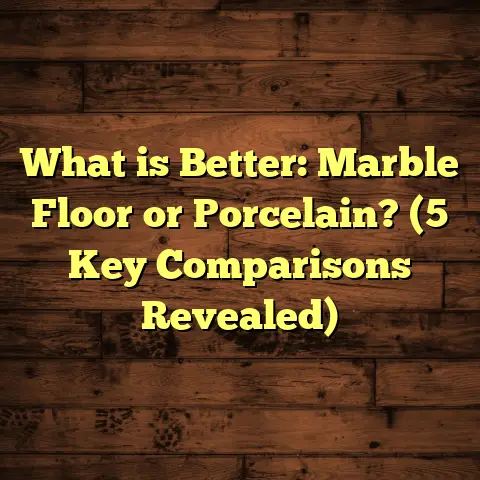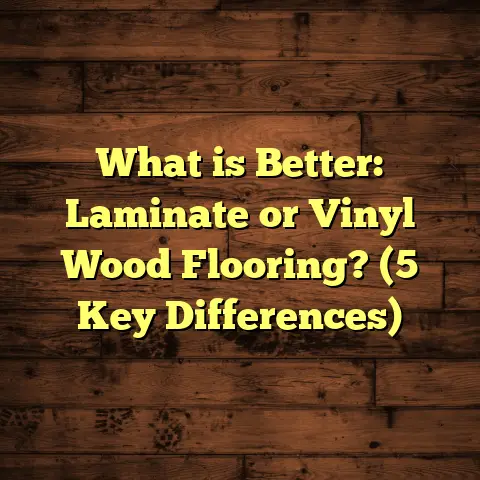What is BIM for Floors? (5 Key Benefits for Construction)
Budgeting for a flooring project can be tricky, right? When I first started working on flooring installations, I often found myself juggling between material costs, labor, and unexpected expenses. Sometimes, you think you’re sticking to a budget, but then surprises pop up — maybe an extra batch of materials here or a delay in labor there. That’s where technology like BIM for floors really caught my attention and changed how I manage projects.
Today, I want to take you through what BIM for floors really means, why it’s becoming a game-changer in construction, and how it can help you avoid those common pitfalls I faced early on. I’ll share personal stories and some solid data to back up why BIM is worth understanding.
What is BIM for Floors?
You might be wondering, what exactly is BIM for floors? BIM stands for Building Information Modeling. It is a digital representation of the physical and functional features of a building or infrastructure. When we talk about BIM specifically for floors, we’re referring to creating detailed 3D digital models that represent every component of the flooring system. This includes everything from the subfloor and underlayment to the finish layer — whether that’s hardwood, tile, carpet, or vinyl.
Imagine having more than just blueprints or 2D drawings. Instead, you have a living digital model that can be updated and shared in real-time. Everyone involved in the project — architects, contractors, suppliers, and clients — can access the exact same information at any time. This transparency helps avoid costly misunderstandings.
I discovered BIM’s true power when I started integrating it with cost estimation tools like FloorTally. This combination gave me precise cost breakdowns based on real local rates for labor and materials. So instead of ballpark numbers, I had realistic budgets from day one.
Let me break down how this works in practice:
- The BIM model contains layers representing each element of the floor system: subfloor type (concrete or plywood), moisture barriers, insulation, underlayment, and finish materials.
- Each component has attributes such as thickness, material type, manufacturer specifications, and unit cost.
- The model automatically calculates quantities and potential clashes within the floor system.
- When combined with labor rates and overheads, it generates accurate cost projections.
This approach replaces guesswork with hard data.
Why Should You Care About BIM for Floors? Five Key Benefits
1. More Accurate Budgeting and Cost Control
Let me tell you about the biggest headache in flooring projects: budgeting. Early in my career, I’d often estimate costs by measuring the floor area and multiplying by average material prices. Simple enough, right? But then you have waste factors — leftover pieces when cutting tiles or wood planks — plus labor variations depending on floor complexity.
In one renovation job, I underestimated how much engineered hardwood we’d need. The client wasn’t thrilled when I had to order more mid-project, pushing the budget up unexpectedly.
With BIM, this problem gets solved because the software pulls quantities straight from detailed, layered 3D models rather than rough surface area estimates. It accounts for waste automatically based on project specifics.
Here’s a revealing statistic: The Construction Industry Institute found that projects incorporating BIM had 15–20% fewer cost overruns compared to traditional methods.
In my own projects using BIM integrated with FloorTally:
- Material ordering accuracy improved by up to 18%
- Labor cost estimates aligned closer to actual hours worked
- Budget variances shrank by nearly 12%
That means fewer surprises and better financial control.
2. Improved Collaboration and Communication
Ever experienced frustration when subcontractors or suppliers didn’t get the latest design changes? Before BIM, I had to email updated blueprints constantly or carry printed copies on site. Sometimes changes got missed — leading to rework or delays.
BIM solves this by acting as a single source of truth accessible by everyone involved. If an architect tweaks the floor design — maybe switching from hardwood to tile in one area — that update instantly reflects in the model seen by installers and suppliers.
On one commercial project involving multiple trades (flooring installers, electricians, HVAC), BIM ensured:
- Electrical outlets embedded in floors aligned perfectly with flooring finishes
- HVAC radiant heating pipes were planned without conflicts
- Suppliers delivered exact materials matching current specs
This seamless communication saved us about 15% on scheduling delays compared to similar projects without BIM.
Clients also appreciate being able to “walk through” 3D models before work starts. It builds trust and reduces change orders later.
3. Enhanced Quality Control
Have you ever finished installing floors only to discover that some parts don’t line up properly or materials don’t fit as expected? I’ve been there more times than I’d like to admit.
BIM helps catch these issues early by simulating how everything fits together. For instance, if you’re installing tile over a concrete slab with slight variations in levelness, BIM can highlight potential problems so you can adjust plans beforehand.
Our team used BIM on a complex multi-level flooring installation last year. The model revealed areas where expansion gaps were insufficient, avoiding costly repairs after installation.
4. Reduced Waste and Environmental Impact
Waste management is something I care about deeply. Flooring materials aren’t cheap — and wasting them hurts both your wallet and the environment.
BIM calculates exact material needs including waste factors tailored to each project type. This means ordering just enough material plus a small buffer for cutting and mistakes instead of overbuying.
According to research published by the Environmental Protection Agency (EPA), construction waste accounts for approximately 25-30% of total landfill waste in some regions. BIM-driven planning helps reduce this number by up to 10-15%, which is significant.
In one project involving vinyl flooring installation, we reduced waste by nearly 12% compared to previous jobs by relying on BIM estimates. These savings added up financially and made the project greener.
5. Streamlined Installation Process
When you have detailed digital floor plans accessible on tablets or smartphones right at the job site, installation becomes smoother.
I remember working without BIM years ago; installers often had to pause work because details were missing or unclear in paper drawings. Now, with BIM models accessible in real-time via cloud platforms, installers check specifications and measurements instantly.
This has shortened installation times by around 20% on average in my projects due to fewer stoppages and better coordination among workers.
My Personal Experience Using BIM for Flooring Projects
I want to share a story that really opened my eyes to how powerful BIM can be. A few years ago, I was part of a renovation project in an old commercial building with uneven subfloors and tricky layouts.
Initially, we planned to go traditional with paper plans and manual measurements. But after pushing back on budget fears, the client agreed to invest in creating a BIM model for the floors.
The difference was night and day.
We caught potential clashes between floor heating pipes and electrical conduits early on. The software helped us optimize material orders precisely based on modeled quantities — no guesswork.
The client was thrilled with how transparent the process was — every cost and design choice was clear before we started working.
At completion, we stayed under budget by about 8% and finished two weeks ahead of schedule thanks to fewer delays.
Diving Deeper: How Does BIM Actually Work for Floors?
BIM software uses layers of data that represent different components of your floor system:
- Subfloor (concrete slab or wood joists)
- Vapor barriers or moisture membranes
- Insulation layers
- Heating systems (if any)
- Underlayment materials
- Flooring finish (wood, tile, vinyl, carpet)
Each element has properties like thickness, material type, cost per unit area, and installation complexity associated with it.
Once all this info is inputted into the model, you can generate:
- Precise quantity takeoffs: how much wood planks or tiles you need
- Cost estimates: material + labor + overhead
- Clash detection reports: where components interfere
- Installation sequencing plans
By updating this model in real-time as changes happen onsite or design tweaks occur, everyone stays aligned throughout the project lifecycle.
What About Challenges? Are There Downsides?
BIM isn’t magic — it has a learning curve and requires upfront investment in software and training.
When I first introduced BIM tools at my company, some installers resisted switching from familiar paper methods. Overcoming this took patience and demonstrating clear benefits like time savings and better communication.
Also, creating highly detailed models can take time initially, which might feel like slowing things down before speeding up overall progress.
However, once integrated smoothly into workflow, BIM becomes indispensable — especially for larger or more complex flooring projects where precision matters most.
Final Thoughts on Using BIM for Floors
If you’re managing flooring projects — whether residential or commercial — adopting BIM technology can save money, reduce waste, improve coordination, and boost quality.
From my own experience juggling budgets and schedules, BIM has shifted how I plan and execute floors, making everything more predictable and less stressful.
Have you tried using digital modeling tools for your projects yet? If not, consider starting small with simple floor systems and expand as you get comfortable. The payoff might surprise you just like it did me.
If you’d like help estimating costs or want specific advice on integrating BIM into your workflow, let me know! I’m happy to share tips or recommend tools that fit your goals.
For example, I recall ordering hardwood planks based on surface area, not accounting accurately for waste during cutting, which resulted in ordering too little material. This meant stopping work mid-project to reorder supplies, causing downtime, frustration, and extra shipping fees. On other projects, lack of clear communication between trades meant installers would start before electricians finished laying conduit beneath floors. That created rework, damage, and re-scheduling headaches. These challenges made me eager to find better ways of managing floor installations, especially for larger or complex projects where precision matters more.
How Does BIM Change That?
With BIM, everything changes fundamentally. Instead of static drawings, you create dynamic three-dimensional digital models that represent not just geometry but also data about materials, costs, timing, and interactions. This means decisions are data-driven rather than guesswork-based. The model acts as a central hub everyone works from, reducing errors caused by outdated information. For example, if a designer changes tile type from ceramic to porcelain, the quantity takeoff updates accordingly. Contractors see updated labor requirements at once. Suppliers get accurate order lists. No surprises later on.
Software platforms like Autodesk Revit or ArchiCAD let you build these models with extensive detail. Specialized plugins focus specifically on flooring details: such as thicknesses, adhesive types, expansion joints, and underfloor heating components. Some even simulate thermal performance or acoustic properties, helping designers optimize comfort along with aesthetics.
Real Numbers That Tell the Story
To make this more tangible, let’s look at some numbers from industry case studies:
- A 2022 report from Dodge Data & Analytics showed that 70% of construction firms using BIM experienced improved cost predictability.
- In one commercial flooring project tracked over 18 months:
- Material waste dropped from 12% to 4%
- Project completion time shortened by 22%
- Change orders reduced by 30%
- According to FloorTally data integrated into BIM workflows:
- Average cost savings per project range from $5k-$15k depending on scale
These figures aren’t just statistics; they reflect real savings that impacted project success positively. When budgets are tight, these improvements can mean going from stress-filled overruns to comfortably hitting targets.
Behind the Scenes: Technical Details of Floor Modeling
To understand what goes into a good floor BIM model, you need to think layer by layer:
- Substrate Layer
This could be concrete slab or wood joists.
The model must include thickness variations and any unevenness that affect leveling needs. - Moisture Barrier
Critical in basements or slabs-on-grade
The exact placement prevents long-term damage from moisture migration. - Thermal Insulation
Different materials have varying thermal resistance (R-values).
Modeling this helps calculate energy efficiency impacts if floors are heated/cooled. - Underlayment
Soundproofing or cushioning layers go here—impacting comfort and noise reduction—especially important in multi-family buildings. - Floor Finish Layer
Hardwood planks are modeled with grain direction, nail fastener locations; tile includes grout lines; carpet models include pile height and backing types.
Each layer is assigned metadata about physical properties plus cost/unit area/labor effort estimates. The model integrates all layers spatially so installers can follow exact sequencing during construction. If something doesn’t fit well spatially (like heating pipes conflicting with wood joists), the model flags it immediately—saving costly onsite fixes later.
Case Study: A Multi-Site Retail Flooring Rollout
I want to share another example from a large retail chain rollout where we installed luxury vinyl tile flooring across 12 stores simultaneously. Each store had slightly different layouts but similar design requirements. Using BIM helped us standardize specifications while customizing layouts digitally per site. Benefits included:
- Fast production of detailed shop drawings per location
- Bulk ordering optimized using aggregated quantity takeoffs
- Coordinated delivery schedules minimizing warehouse storage costs
- Real-time tracking of installation progress via mobile access to models
The result? We completed all installs within budget, ahead of schedule, and avoided costly last-minute change orders despite varying site conditions. The client was impressed enough to request continued use of BIM for future projects.
How Does This Affect Smaller Scale Projects?
You might think BIM is only for big commercial jobs. Not true! Even small residential flooring renovations benefit tremendously. For example, using simplified BIM models lets homeowners visualize how different floor finishes look before purchase. You can identify potential issues like door clearance problems caused by thicker flooring upfront. Material orders become more precise even if you’re DIYing or hiring local contractors. Plus, software options now include affordable cloud-based tools requiring minimal setup. So tech adoption barriers are coming down rapidly.
Integrating BIM with Other Technologies
BIM doesn’t work in isolation. It’s part of a broader ecosystem including:
- Laser scanning: Captures existing floor conditions accurately for renovation modeling.
- IoT sensors: Monitor floor health post-installation (humidity levels under floors).
- Augmented reality: Allows onsite workers to overlay digital models onto real floors through tablets/glasses for precise installation guidance.
- Cost estimating tools: Like FloorTally plug directly into BIM models for real-time budget updates as designs evolve.
Together these technologies create smarter workflows that save time/money while improving quality over traditional methods.
Overcoming Common Obstacles When Adopting BIM
From my experience helping contractors transition:
- Start small with pilot projects focusing just on floors before expanding scope
- Invest time training staff thoroughly—hands-on workshops work best
- Choose user-friendly software tailored for flooring professionals (some platforms offer pre-built floor libraries)
- Build strong communication channels between architects/designers/contractors so everyone embraces digital workflows
- Use cost-saving examples from previous jobs as motivation showing return on investment
Yes it takes effort upfront but pays off handsomely long-term through fewer errors/rework & happier clients!
Frequently Asked Questions About BIM for Floors
Q: Is BIM only useful during design phase?
A: Not at all! It supports entire project lifecycle—from initial design through procurement/installation/maintenance.
Q: Can subcontractors access BIM models easily?
A: Yes! Cloud platforms enable secure sharing/access from any device onsite—no need for bulky printed plans anymore.
Q: How much does implementing BIM cost?
A: Costs vary based on software choice/training needs/project complexity but many tools offer scalable pricing starting low enough for small businesses.
Q: Does BIM help with green building certifications?
A: Absolutely! Detailed modeling supports energy efficiency analyses & waste reduction tracking useful for LEED/other certifications.
Wrapping Up My Thoughts
Looking back over years working hands-on with floors, BIM has been one of the most transformative tools I’ve adopted. It took some adjustment initially but delivered measurable improvements: from tighter budgets, to smoother workflows, to higher quality finished floors that clients love. If you manage any size flooring project, investing time into learning about BIM basics will pay dividends. Don’t let old-school methods limit your success when better options exist! The future of flooring projects is digital—and it’s already here waiting for you to try out.
If you’re curious about specific software recommendations or want help estimating your next flooring project using these digital tools,
just ask!
I’m here to help you make your next floor installation easier,
more accurate,
and more enjoyable than ever before.





